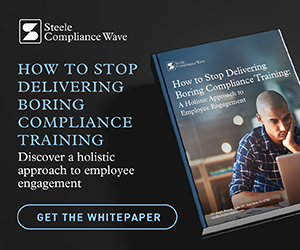 Making compliance training more engaging has clear benefits for compliance professionals, employees and the organization as a whole. The question is: How do you make training more enjoyable as well as more effective in reducing business risks?
Making compliance training more engaging has clear benefits for compliance professionals, employees and the organization as a whole. The question is: How do you make training more enjoyable as well as more effective in reducing business risks?
Ethics and compliance professionals may have the best of intentions when trying to introduce engaging material, but it’s easy to make mistakes that undermine the training’s effectiveness.
Incorporating multimedia, multi-modal communications into compliance training provides more opportunities for learning and retaining compliance information. But remember, compliance communication and training is serious business, and it’s important that every tool you use contribute to creating a culture of compliant behavior. As you work on making your compliance training more engaging, here are three pitfalls to avoid:
1. Providing Too Much Information
Burdening your audience with too much information is a sure way to lose their attention and obscure the message you need to convey. For C&E professionals, there’s a real temptation to share everything they’ve learned about a compliance topic. They’ve done extensive research, and what they’ve uncovered is relevant and important – to them, but not necessarily to their audience.
A common mistake is to go into way too much detail about the legislation behind your company’s policy. Training sessions tend to pile on facts about the legislative and enforcement landscape, and all that technical detail causes employees to tune out – and doesn’t do much to help employees figure out what to do when confronted with an ethical dilemma.
Employees may need to know some general information about the law, but it’s less than many C&E professionals assume. The key is to boil down what you know about a compliance topic, sharing only the most important points and providing relevant advice on what to do in specific, real-life situations.
2. Letting Entertainment Trump Substance
Cartoons, videos and other multimedia communication are useful tools in making compliance training more engaging and effective. Video, for example, may be a powerful avenue for shaping the audience’s emotional engagement, using music, pacing and other techniques.
Adding humorous and entertaining content is often a good way make your training more engaging, as long as the laughter supports the learning. Too often, the entertainment aspect of a video or cartoon obscures the substantive message you want to convey, wasting everyone’s time. People may be engaged, yes – but are they learning?
3. Lacking Clear Takeaways
Many types of compliance training suffer from obscured or non-existent takeaways. After spending 30 or 40 minutes on an e-learning training session, employees won’t necessarily know what they should do in a challenging situation.
A typical training on bribery, for example, might spend most of the time telling employees about the laws that govern bribery. When it finally gets to the point, employees learn what not to do – something like, “If you’re in a foreign customs office and an official asks you for a bribe, don’t give it.” Then, the employees take an assessment, and the training is done.
“Don’t give the bribe” is certainly good advice, but it’s not particularly useful counsel for employees who actually find themselves being asked for a bribe in real life. Effective compliance training needs to provide employees with the guidance not only on what not to do, but also on what to do.
As you work to make your compliance training more engaging, remember that training isn’t an end in itself – or just a way to avoid violating the law. Stopping an ethical or legal violation is important, but it doesn’t actually move the business forward.
Effective compliance communication and training requires compliance professionals to put real thought into the structure, tone and content of the materials and to communicate through multiple modalities. Striking the right balance isn’t easy, but the potential benefits are significant: Not only do you protect your company from significant liabilities, but you also empower your employees to conduct business in an ethical, compliant and profitable manner.




